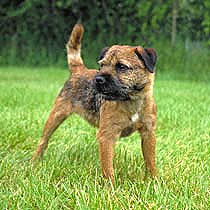|
The Canine Chronicles Directory
Border Terrier

Border Terriers are medium-sized with a coarse, wiry double coat. The coat is harsh
and dense with a close undercoat and the skin must be thick. Their coats usually
need stripping twice a year. Preferred show ring colors are red, wheaten, grizzle
and tan, or blue and tan. Patches of white on the chest are permissible although
white on the feet is not allowed. Their heads are otter-like in shape with a strong,
broad muzzle. They have strong jaws with teeth meeting in a scissor-like bite. Their
eyes are dark and their noses should be black. Liver or flesh colors are also allowed
when showing this breed. The small, triangular shaped ears drop forward and lie
close to the cheek. The neck should be moderately long. The body should be narrow
and the chest medium in depth. The short tail sets high and tapers from base to
tip.
|
|
Temperament
|
Border Terriers are affectionate, brave and adaptable dogs. Although they are easy-going,
they are independent and tend to have a mind of their own. Border Terrier puppies
are very active. It is important that they are thoroughly socialized since they
may go through a shy phase, especially in noisy or city environments. This breed
enjoys digging and should have reinforced areas along the bottoms of the fencing.
Border Terriers are great with children and will get along with household cats if
raised with them. They will not get along with cats outside of the family and should
not be allowed around hamsters, rabbits, rats, birds or other small animals. This
breed can become destructive if left alone for extended periods of time and more
than one male Border Terrier should not live in the same family.
|
|
Height, Weight
|
Male Height: 13-16" ; Weight: 13-16 lbs.
Female Height: 11-14" ; Weight: 11-14 lbs.
|
|
Health Problems
|
Canine Epileptoid Cramping Syndrome - CECS (aka Spike's Disease) is a major health
concern with the Border Terrier. Because this breed shows few signs of an illness,
they should be watched carefully for subtle health changes.
|
|
Living Conditions
|
Borders Terriers will do fine with apartment living but do better with a small yard.
|
|
Exercise
|
This breed is lively and is bred to hunt. They require lots of exercise.
|
|
Life Expectancy
|
15 or more years
|
|
Grooming
|
The Border Terrier is easy to groom. Only bathe when necessary. This breed goes
for the natural look. They should be professionally groomed twice a year. Because
they shed little or no hair, they are good for allergy sufferers.
|
|
Origin
|
Although their origin is unknown, Border Terriers appeared during the 18th century
in the Cheviot Hills area near the Scottish/English border. They were used to compel
predatory foxes from their dens and kill them. Their extra strong legs gave them
the capability to follow a horse when needed. During the time that this breed was
used for hunting marten, otter and the fierce badger, they were known as Reedwater
Terriers and Coquetdale Terriers. Border Terriers have changed very little over
time and are still used as working terriers in the English countryside today. This
breed was officially recognized by the British Kennel Club in 1920, by the AKC in
1930 and by the UKC in 1948.
|
|
Group
|
AKC and UKC Terrier
|